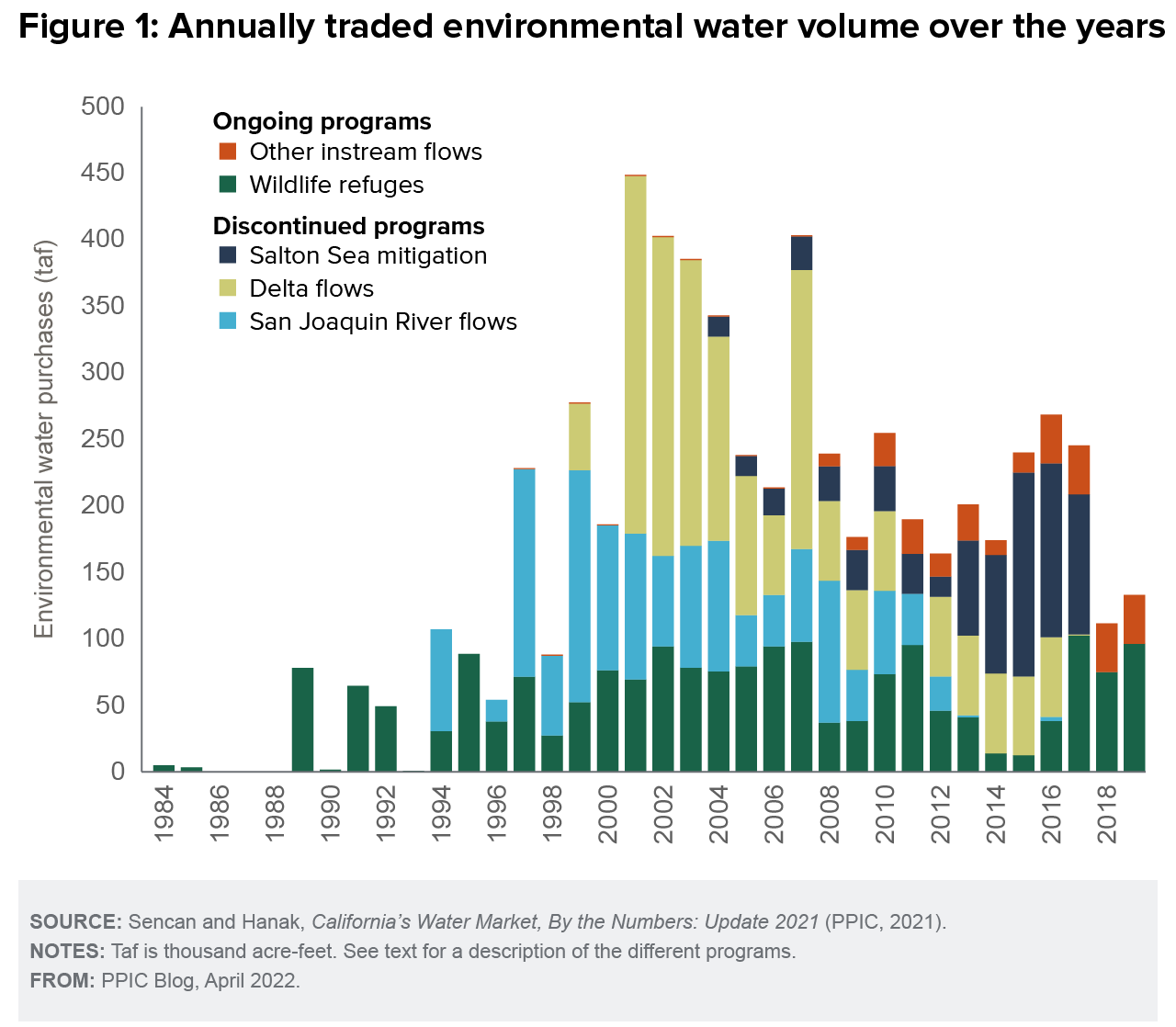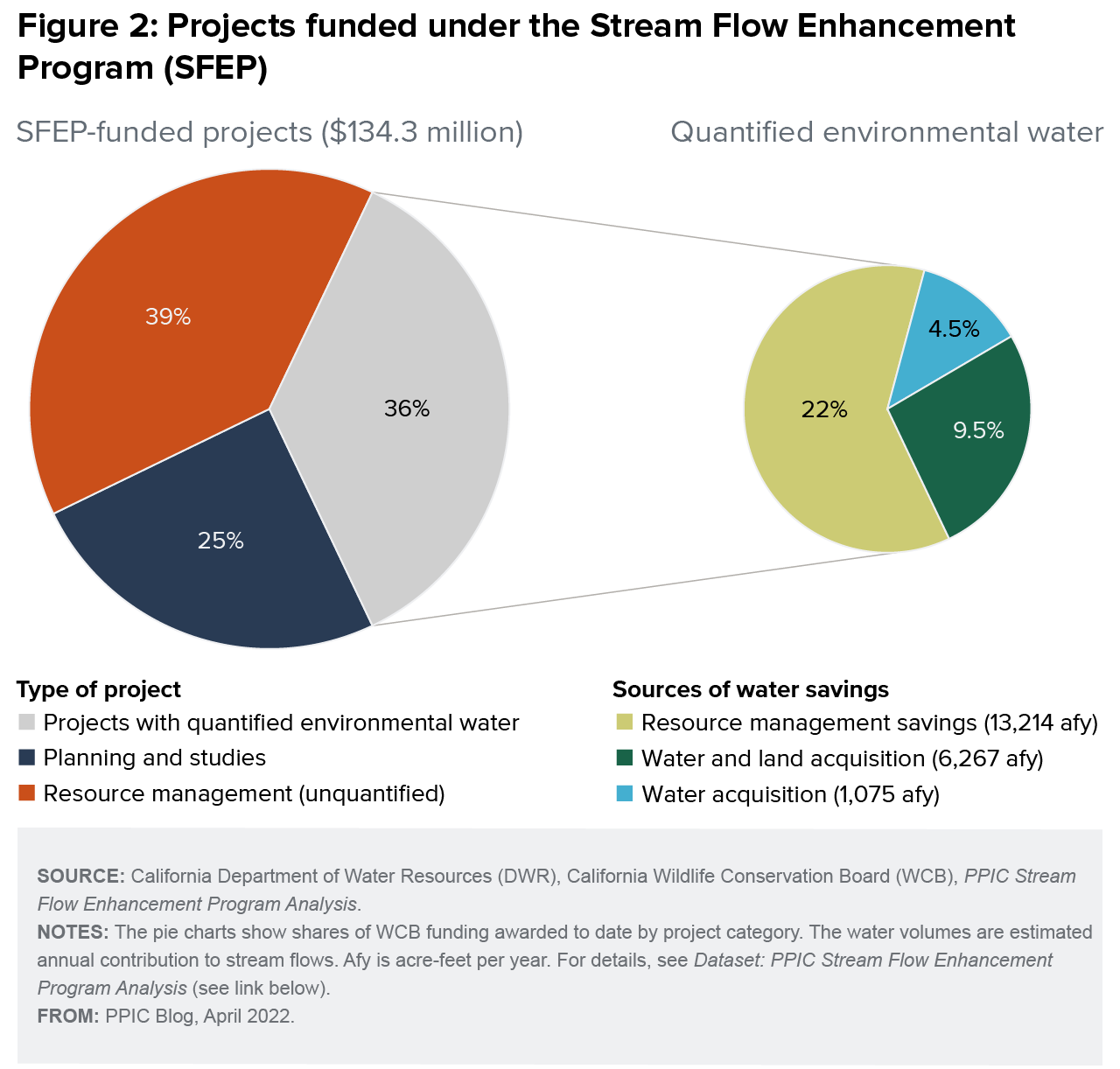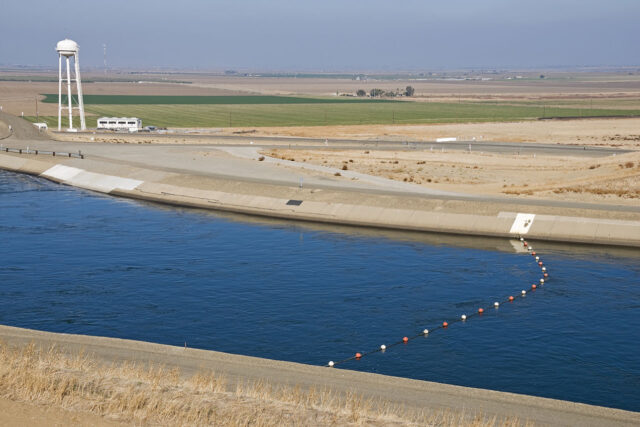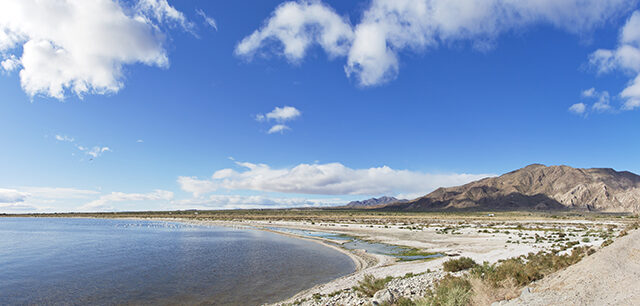Adding more water to rivers, wetlands, and streams at key times can support California’s struggling native fishes and birds. Regulation is one way to do this, by requiring water users to leave a certain amount of water instream. A complementary approach is water trading. Paying water users to make water available can enhance the environment while reducing conflict over the allocation of scarce supplies. Despite trading’s promise, however, there are questions about the path forward.
What Do Environmental Water Purchases Buy—and Who Pays?
Purchasing water to improve ecosystems (e-water) started in the 1980s, and gained significant momentum in the 1990s (Figure 1). From 1984–2019, some 6 million acre-feet (maf) of e-water were acquired, about a quarter of all purchases on California’s water market. In today’s dollars, almost $775 million went to this effort, with nearly half from state and federal taxes, and the remainder from surcharges on water use. But e-water purchases peaked in the 2000s, and by 2019 they were lower than any time since the late 1990s.

The decline reflects the expiration of several large programs (and the associated funding):
- San Joaquin River flows (23% of all e-water purchases) ended in the early 2010s and was funded by water users, through the Central Valley Project Improvement Act (CVPIA) restoration fund.
- Delta flows (29% of purchases), known as the Environmental Water Account, acquired water for endangered salmon and smelt in the Delta watershed and expired in 2016. State and federal taxpayers provided funding.
- Salton Sea mitigation (13% of purchases) offset salinity increases in the Salton Sea caused by Imperial County farmers’ water transfers to coastal urban cities. Funded by the trading parties, it expired in 2017 when the state took over responsibility for mitigation.
Relaunching these e-water purchases could support important goals. A newly-announced cooperative agreement for the Delta watershed proposes transfers to improve conditions for fishes. And though not currently on the table, transfers could help protect habitat and public health in the Imperial Valley.
The two ongoing e-water purchase programs are quite distinct in size and scope:
- Wildlife refuges (30% of purchases) boosts supplies to Central Valley wildlife refuges—a key resource on the Pacific Flyway. After some initial state support, the CVPIA restoration fund has been the main funder.
- Other instream flows (5% of purchases) permanently dedicates water rights to the environment with permits from the State Water Board under Section 1707 of the Water Code. Projects are small and local; philanthropic organizations and NGOs typically raise the funds.
A New Model for Enhancing E-Water?
Most past state funding for e-water came from water bonds, and it mainly went toward short-term (single-year) purchases. Designers of Proposition 1, a bond approved in 2014, tried something new by earmarking $200 million for a Stream Flow Enhancement Program (SFEP) at the Wildlife Conservation Board (WCB).
In spirit, the SFEP is in line with the broad-based instream flow approach (the orange bars in Figure 1); applicants seek grants to directly enhance flows, or to plan and study opportunities. The program focuses on long-term (20 years minimum) or permanent improvements.
With 128 projects and nearly $135 million awarded to date, the data reveal some surprises (Figure 2). First, acquisition of e-water—either on its own, or in conjunction with land—makes up a relatively small share of awards (14% of funds). Instead, the lion’s share (61%) supports resource management projects that enhance flows in other ways—such as storage that shifts flow timing, and urban conservation and restoration efforts that will save water (e.g., clearing arundo—a thirsty, invasive riparian plant). The remainder (25%) goes to planning and studies.

Stakeholders told us that the pivot towards more flexible resource management solutions reflects challenges with outright e-water acquisitions under the SFEP. First, the Section 1707 permitting process to acquire an instream water right can be both costly and cumbersome—especially for small transfers. Second, many potential water sellers are just beginning to explore e-water transfers and aren’t ready for permanent sales. Permanent transfers are generally rare in California’s water market, so e-water marketing is no different.
Water savings from some efforts (e.g., arundo clearing) are hard to quantify. Where it could quantify savings, the WCB estimates that e-water enhancements, once completed, will total roughly 21,000 af per year (Figure 2). Since these projects last for at least 20 years, they come at a similar unit cost to the e-water purchases described above (Figure 1)—averaging $115–$130 per acre-foot per year.
Looking Ahead
Water acquisitions can help struggling ecosystems, and sustained funding from both water users and the state is key. Compared to past state funding for e-water, the SFEP represents a significant—and growing—opportunity: it received $100 million from the General Fund last September, and another $150 million is proposed this year. But the program should facilitate more acquisitions, because options for growing the water pie through resource management actions are often limited. Several changes could help, including flexibility to allow shorter-term purchases and a streamlined 1707 permitting process. Finally, to scale up impact, it will be important to encourage larger projects—and coordinated projects within watersheds. The legislature and the two key state agencies—the Wildlife Conservation Board and State Water Board—should lead this work.
To see the full data set on SFEP Proposition 1 funding, PPIC Stream Flow Enhancement Program Analysis, please click here.






